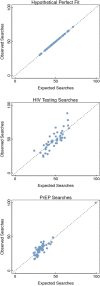Monitoring HIV testing and pre-exposure prophylaxis information seeking by combining digital and traditional data
- PMID: 33632140
- PMCID: PMC7908754
- DOI: 10.1186/s12879-021-05907-0
Monitoring HIV testing and pre-exposure prophylaxis information seeking by combining digital and traditional data
Abstract
Background: Public health is increasingly turning to non-traditional digital data to inform HIV prevention and control strategies. We demonstrate a parsimonious method using both traditional survey and internet search histories to provide new insights into HIV testing and pre-exposure prophylaxis (PrEP) information seeking that can be easily extended to other settings.
Method: We modeled how US internet search volumes from 2019 for HIV testing and PrEP compared against expected search volumes for HIV testing and PrEP using state HIV prevalence and socioeconomic characteristics as predictors. States with search volumes outside the upper and lower bound confidence interval were labeled as either over or under performing. State performance was evaluated by (a) Centers for Disease Control and Prevention designation as a hotspot for new HIV diagnoses (b) expanding Medicaid coverage.
Results: Ten states over-performed in models assessing information seeking for HIV testing, while eleven states under-performed. Thirteen states over-performed in models assessing internet searches for PrEP information, while thirteen states under-performed. States that expanded Medicaid coverage were more likely to over perform in PrEP models than states that did not expand Medicaid coverage. While states that were hotspots for new HIV diagnoses were more likely to over perform on HIV testing searches.
Conclusion: Our study derived a method of measuring HIV and PrEP information seeking that is comparable across states. Several states exhibited information seeking for PrEP and HIV testing that deviated from model assessments. Statewide search volume for PrEP information was affected by a state's decision to expand Medicaid coverage. Our research provides health officials with an innovative way to monitor statewide interest in PrEP and HIV testing using a metric for information-seeking that is comparable across states.
Keywords: Google trends; HIV; HIV testing; Internet; PrEP.
Conflict of interest statement
None of the authors declares any conflicts of interest.
Figures
Similar articles
-
Using Search Engine Data to Explore Interest in PrEP and HIV Testing in the United States.AIDS Behav. 2021 Mar;25(3):983-991. doi: 10.1007/s10461-020-03057-z. Epub 2020 Oct 8. AIDS Behav. 2021. PMID: 33033997
-
Policy- and county-level associations with HIV pre-exposure prophylaxis use, the United States, 2018.Ann Epidemiol. 2020 May;45:24-31.e3. doi: 10.1016/j.annepidem.2020.03.013. Epub 2020 Apr 3. Ann Epidemiol. 2020. PMID: 32336655 Free PMC article.
-
Access to PrEP and other sexual health services for cisgender women in the United States: a review of state policy and Medicaid expansion.Front Public Health. 2024 Jun 25;12:1360349. doi: 10.3389/fpubh.2024.1360349. eCollection 2024. Front Public Health. 2024. PMID: 38983260 Free PMC article. Review.
-
The prevalence of pre-exposure prophylaxis use and the pre-exposure prophylaxis-to-need ratio in the fourth quarter of 2017, United States.Ann Epidemiol. 2018 Dec;28(12):841-849. doi: 10.1016/j.annepidem.2018.06.005. Epub 2018 Jun 15. Ann Epidemiol. 2018. PMID: 29983236 Free PMC article.
-
Barriers to the Wider Use of Pre-exposure Prophylaxis in the United States: A Narrative Review.Adv Ther. 2020 May;37(5):1778-1811. doi: 10.1007/s12325-020-01295-0. Epub 2020 Mar 30. Adv Ther. 2020. PMID: 32232664 Free PMC article. Review.
Cited by
-
Relative Effectiveness of Social Media, Dating Apps, and Information Search Sites in Promoting HIV Self-testing: Observational Cohort Study.JMIR Form Res. 2022 Sep 23;6(9):e35648. doi: 10.2196/35648. JMIR Form Res. 2022. PMID: 36149729 Free PMC article.
-
Managing HIV During the COVID-19 Pandemic: A Study of Help-Seeking Behaviors on a Social Media Forum.AIDS Behav. 2024 Apr;28(4):1166-1172. doi: 10.1007/s10461-023-04134-9. Epub 2023 Jul 21. AIDS Behav. 2024. PMID: 37479919 Free PMC article.
References
-
- Asur S, Huberman BA. Predicting the future with social media. In: Proceedings - 2010 IEEE/WIC/ACM International Conference on Web Intelligence, WI 2010. ; 2010. doi:10.1109/WI-IAT.2010.63
-
- Ayers JW, Althouse BM, Dredze M, Leas EC, Noar SM. News and internet searches about human immunodeficiency virus after Charlie Sheen’s disclosure. JAMA Intern Med. 2016. 10.1001/jamainternmed.2016.0003. - PubMed
-
- AIDSVu (aidsvu.org). Emory University, Rollins School of Public Health. Accessed 10 Mar 2020.
MeSH terms
Grants and funding
LinkOut - more resources
Full Text Sources
Other Literature Sources
Medical
Miscellaneous


